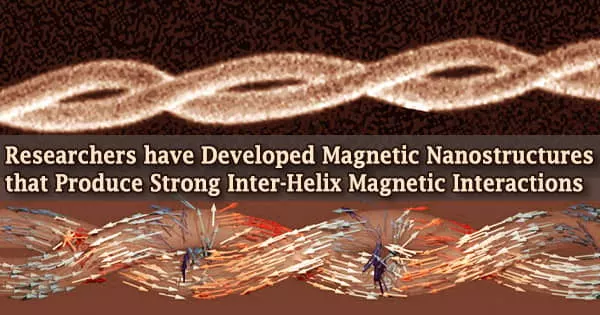Scientists have utilized cutting-edge 3D printing and imaging to provide a new look at what occurs when you take magnets to the nanoscale, which is 1000 times smaller than a human hair.
The international team, led by the Cavendish Laboratory at Cambridge University, used an advanced 3D printing technology they developed to create magnetic double helices that twist around one another, combining curvature, chirality, and strong magnetic field interactions between the helices, similar to the double helix of DNA.
The scientists observed that these magnetic double helices form nanoscale topological textures in the magnetic field, which had never been seen previously, paving the way for new magnetic gadgets. The findings were published in the journal Nature Nanotechnology.
Magnets are employed for energy generation, data storage, and computation, and they have an impact on many aspects of our society. In two-dimensional systems, however, magnetic computing devices are rapidly reaching their limit.
There is growing interest in shifting to three dimensions for the next generation of computing, where three-dimensional geometries can modify the magnetic properties and give new functionality, in addition to achieving larger densities with 3D nanowire designs.
There has been a lot of work around a yet-to-be-established technology called racetrack memory, first proposed by Stuart Parkin. The idea is to store digital data in the magnetic domain walls of nanowires to produce information storage devices with high reliability, performance, and capacity.
Claire Donnelly
“There has been a lot of work around a yet-to-be-established technology called racetrack memory, first proposed by Stuart Parkin. The idea is to store digital data in the magnetic domain walls of nanowires to produce information storage devices with high reliability, performance, and capacity,” said Claire Donnelly, the study’s first author from Cambridge’s Cavendish Laboratory, who has recently moved to the Max Planck Institute for Chemical Physics of Solids.
“But until now, this idea has always been very difficult to realize, because we need to be able to make three-dimensional magnetic systems and we also need to understand the effect of going to three dimensions on both the magnetisation and the magnetic field.”
“So, over the last few years our research has focused on developing new methods to visualize three-dimensional magnetic structures think about a CT scan in a hospital, but for magnets. We also developed a 3D printing technique for magnetic materials.”
The 3D measurements were carried out at the Swiss Light Source’s PolLux beamline at the Paul Scherrer Institute, which is currently the only beamline capable of soft X-ray laminography. The researchers discovered that the 3D DNA structure results in a different texture in the magnetisation than what is visible in 2D using these modern X-ray imaging techniques.
Magnetic domains (regions where all magnetization points in the same direction) in neighboring helices are highly linked and deform as a result of this. These walls are attracted to one another and spin as a result of the 3D structure, “locking” into place and producing strong, regular linkages, akin to DNA base pairs.
“Not only did we find that the 3D structure leads to interesting topological nanotextures in the magnetisation, where we are relatively used to seeing such textures, but also in the magnetic stray field, which revealed exciting new nanoscale field configurations!” said Donnelly.
“This new ability to pattern the magnetic field at this length scale allows us to define what forces will be applied to magnetic materials and to understand how far we can go with patterning these magnetic fields. If we can control those magnetic forces on the nanoscale, we get closer to reaching the same degree of control as we have in two dimensions.”
“The result is fascinating the textures in the DNA-like double helix form strong bonds between the helices, deforming their shape as a result,” explained lead author Amalio Fernandez-Pacheco, former Cavendish Researcher, now working at the Institute of Nanoscience & Materials of Aragón. “But what is more exciting is that around these bonds form swirls in the magnetic field topological textures!”
Donnelly and her coworkers from the Paul Scherrer Institute and the Universities of Glasgow, Zaragoza, Oviedo, and Vienna will now study the full possibilities of going from two to three dimensions in terms of the magnetic field.
“The prospects of this work are manyfold: these strongly bonded textures in the magnetic helices promise highly robust motion and could be a potential carrier of information,” said Fernandez-Pacheco.
“Even more exciting is this new potential to pattern the magnetic field at the nanoscale, this could offer new possibilities for particle trapping, imaging techniques as well as smart materials.”





